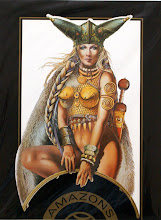Ray Aspden has been a irregular comic strip writer and illustrator for 35 years, contributing 'Philpot Bottles' Orfice Boys Own' to Denis Gifford's Ally Sloper in 1976-77, a cartoon strip that harked back to the 1930s penny comics, which would often feature a column from the paper's office boy recounting (in badly spelled text) what had been happening that week.
Ray, also a playwright, started writing for D. C. Thomson in the late 1970s, selling two strories to Victor, of which only one appeared ('Stokehold Joe' in 1980). In 1978, having spotted an advert in The Guardian, he contacted the editors of the upcoming science fiction pocket library, Starblazer, and began contributing scripts. His first submission, 'The Basilisk Face of Fear' - based loosely on the story of Perseus and the Gorgon's head, was accepted and published as Starblazer #2, 'The Domes of Death'. A second story, a reworking of the legend of Theseus and the Minotaur, followed, published as 'Sinister City' (Starblazer #19).
Ray eventually became one of Starblazer's most regular writers, penning 28 issues published between 1979 and 1986. Discussing his work for the series recently, he admitted that the pattern set for those years was to have one in three of his outlines accepted, either immediately or after some amendment. One ploy used by the editors was to send a cover, bought through an agency, and have Ray write a story around it - 'Terror Tomb' (Starblazer #62) being one example.
His best-known work for the series featured Hadron Halley, the idea springing from a reversal of 'sci-fi' (science fiction) - that fi-sci could stand for Fighting Scientist. The concept of 'Moonsplitter' (Starblazer #50) was to contrast the rational scientific approach of Halley to the gung-ho militarism of General Larz Pluto, although in writing the latter as a buffoon he "transgressed Thomsons moral code of wanting figures of authority to be seen as worthy of respect." He considers the final book "a mess".
"Due to the childhood influence of Eagle, I tried to have characters driving the plot and the nuances of character revealed in the dialogue. Jack and Bill [Starblazer editors] wanted action and gadgets. They also imposed a word limitation on speech bubbles and had total control over the ultimately published dialogue. As a result, many Starblazers based on my scripts have the characters making bland statements of the bleeding obvious instead of the witty one-liners I originally gave them. I used to complain regularly. I think Jack understood that it was nothing personal and told me I shouldn't care so passionately about my creations. His advice was to completely forget about a script once I'd had the cheque and make a start on the next idea." (Ray's article on his days with Starblazer can be found here.)
As well as his Starblazer writing, Aspden also began contributing strips to two Welsh language publications Sboncyn and Deryn in the early 1980s, writing and drawing two humour strips, 'Jac-Do' and 'Alys Ofalus'. Sboncyn was relaunched as Penbwl in 1989, for which Aspden wrote and drew 'Huwi Hurt', a Dennis the Menace-type character which Aspden turned into a Hungry Horace clone. The monthly comic folded in 1995.
Since 2004, Aspden has written and drawn two regular strips for Spaceship Away!. Both 'Mekki' and 'Our Bertie' owe a stylistic debt to the Knockout in the 1950s, rather than Eagle.
Ray's interest in history has also led to him producing illustrations for the series 'Cutha's Chronicles', written by Karl Wittwer and Paul Finlow-Bates, for the quarterly magazine Wiðowinde (Bindweed), for members of The English Companions (a study group for people interested in the Anglo-Saxon period of British history), since 2005; he has also drawn strips for the historical magazine Facts & Fiction and recently supplied illustrations for the book Derbyshire Folk Tales (2010).
An example of Aspden's early work can be found for sale here.
Subscribe to:
Post Comments (Atom)




















No comments:
Post a Comment